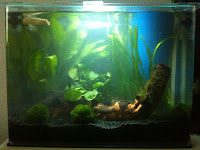So, ever since my last post on algae I have been trying to get rid om them. Here's a short update of the method I chose, that seems to be working so far.
My first wish was to use as little 'medicine' as possible. I read some articles that reminded me of biology class in secondary school: photosynthesis...the magic word. It appears that, as many of you will remember, plants produce O2 (oxigen) in lighted conditions and use CO2 to both produce it and in order to grow. In dark condition the proces reverses and CO2 gets produced through O2 usage. Algae on the other hand appear to use O2 (produced by plants) in daytime conditions in order to grow.
So: Lots of light will result in an overproduction of O2, which gives algae plenty of opportunity to grow. I live in a house very well lit by daylight and the shrimptank can't get away from the daylight as well, although it is pushed back as far away as possible. I also had the Aquatic Nature Solar Boy Duo running 12 hours a day...
Here's what I did:
- I pushed back the timer of the Solar Boy Duo to do only 4 hour sessions, twice a day.
- I darkened the tank throughout the daytime.
Every morning after breakfast, I put a magazine on the shortside (held there by the cleaning magnet) and pulled a trashbag over the front and upside. (Remember the backside is covered with black foil already). I turned the light off to avoid heating and potential fires. With the filter on the opposite shortside and the ligth coming from the oposite direction, darkening that side is hardly worth the effort.
When I got home from work, I removed the foil and started switch the light back on.
Results:
Every week I refresh abouth 30% of the water, and along with it I try to remove as much of the algae I can get my hands on. Usually those were back the week after, but that proces has stopped now!
The anubias nana is almost completely algae-free after three weeks of treatment. The valisneria seems to be getting better, although growth has slowed down significantly!
Only the plant in the back, the Echinodorus, seems to have stopped growing and, although algae are leaving it alone, seems to slowly die on me.
As a side-effect, the moss seems to be enjoying these conditions a lot better as well! It grows better and looks more 'green'. There is also no longer a rag of algae in between the moss.
Here's a picture of my 'darkening method'


















